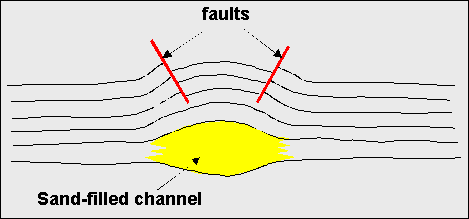Coupled Stratigraphy and Structure Example--North Sea

Coherence and dip azimuth time slices from the North Sea. The channel-shaped feature seen at the bottom of the coherence image is actually a set of inward-facing normal faults. These faults appear as steep, opposing dips on the dip/azimuth slice.

The faults identified in the previous slide line up with the edges of a channel 220 ms deeper in the section.
Schematic vertical section through channel

A schematic vertical section showing the relationship between the faults and the underlying channel. The faults are interpreted as tensional faults caused by differential compaction between the sand-filled channel and the surrounding shale.